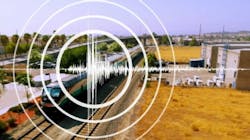Metrolink completes full deployment of early earthquake warning system
Metrolink has completed the full deployment of its advanced ShakeAlert-powered earthquake early warning system along segments of all seven of its passenger rail lines. The completion comes on the eve of the 90th anniversary of the 6.4-magnitude 1933 Long Beach earthquake along the Newport-Inglewood fault.
The system is the final step in a months-long roll out of cutting-edge technology that automatically alerts trains and applies the brakes for safe and rapid slowing or stopping of trains operating on Metrolink-owned tracks in the event of an earthquake.
“Safety is at the foundation of all we do,” said Metrolink CEO Darren Kettle. “We are not able to prevent earthquakes here in southern California, but we now have critical data and technology that allows us to detect shaking earlier, mitigate impacts and save lives. With earthquake early warning technology now available on all our lines, it gives me great satisfaction to know we are doing everything we can to protect our riders and staff.”
Metrolink’s EEW system is based on an interface between the United States Geological Survey ShakeAlert® system and Metrolink’s Positive Train Control (PTC) system. ShakeAlert is an earthquake early warning system that provides important data within seconds of an earthquake being detected, including the earthquake’s location, magnitude and estimated shaking, so people and systems can be alerted before shaking begins. PTC is designed to prevent train-to-train collisions, over-speed derailments and other unsafe actions. Together, the two systems allow trains to detect and respond as quickly as possible to an earthquake while also providing enhanced data to support inspection of the rail network and resumption of service following an earthquake.
“Protecting lives is at the core of the USGS mission,” said USGS ShakeAlert Coordinator Robert deGroot. “It is exciting to partner with Metrolink on this enforced braking technology to enhance safety for train riders and crew when an earthquake is detected by the ShakeAlert system.”
Metrolink’s implementation of ShakeAlert-powered technology is supported through a partnership with the California Department of Transportation (Caltrans) and USGS. It was first introduced on Metrolink in September 2021; however, at that time, the technology did not yet include automated braking. Instead, alerts about imminent shaking were received by dispatching staff who used that information to instruct train engineers to manually slow or stop the train if needed.
Metrolink now automates this process by alerting key train personnel and using Metrolink’s PTC system to enforce braking, so the train can stop or slow down in response to an alert. This allows for a faster reaction to shaking, which could ultimately save lives and/or minimize damage.
Metrolink’s EEW system was first piloted along the 91/Perris Valley Line between Riverside and Perris in June 2022. Since then, Metrolink teams have rolled out the technology along segments of its other six lines spanning six counties in southern California.
